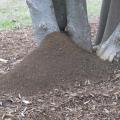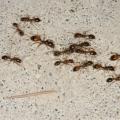Control In Pastures, Hayfields, and Barnyards
Granular fire ant baits are the best way to control fire ants in pastures and hayfields, but it is important to be sure the bait you buy is approved for use around grazing animals.
 Fire ant baits are applied at very low rates, usually one to two pounds per acre. Some companies make spreaders that are specially designed to apply these low rates over large acreage. Depending on the level of control desired, the annual cost of controlling fire ants in a pasture or hay field can range from around $10 to $50 per acre.
Fire ant baits are applied at very low rates, usually one to two pounds per acre. Some companies make spreaders that are specially designed to apply these low rates over large acreage. Depending on the level of control desired, the annual cost of controlling fire ants in a pasture or hay field can range from around $10 to $50 per acre.
See Extension Publication 2493, Control Fire Ants in Pastures, Hayfields, and Barnyards for recommended bait treatments and details on use. Read the section on Fire Ant Biology to learn more about how baits work.
Shipping Hay from Mississippi to Fire Any-Free Areas: All Mississippi counties are infested with imported fire ants and baled hay and straw must be certified as being free of fire ants before it can be shipped to uninfected areas. See the Imported Quarantine Map.
Before shipping hay or straw outside of the Imported Fire Ant Quarantine zone, contact the Mississippi Department of Agriculture’s Bureau of Plant Industry to arrange for inspection(s) and certification. Also see Extension Publication 2733, Imported Fire Ant-Free Hay Certification in Mississippi.
Contact information for Dr. Blake Layton.
Publications
News
Sunshine and long days make summertime in the South desirable for people, but those same conditions are exactly what allows the dreaded, imported fire ants to thrive.
Almost any sunny, grassy area left unattended will soon be home to fire ants. Fire ants were accidentally imported from South America to Mobile in the 1930s and have since spread throughout the Southeast.
Everyone loves a good myth buster, and we have a very timely one for you! Fire ant beds in your yard can be such a headache to deal with. Many people have used home remedies to control ants. But are those quick fixes really getting rid of the ants in your yard? Let’s take a look at some commonly used home remedies and whether or not they work!
Do you have fire ants in your vegetable garden? Me too. Good news for all of us! There are some fire ant baits that are safe to use around food plants.


